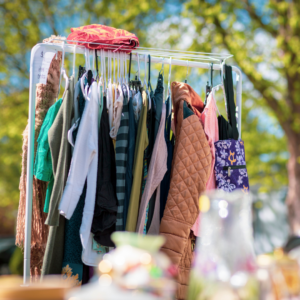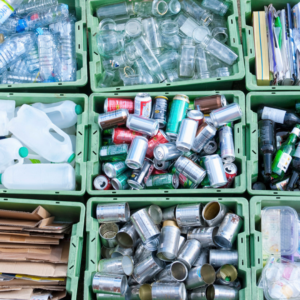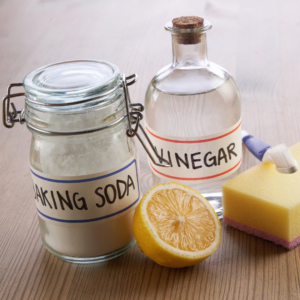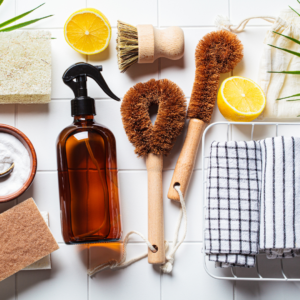March 20 is the official start of spring and a perfect time to evaluate your spring-cleaning to-do list. Beyond the scouring of surfaces and ousting of dust, dirt, and grime that may have gone unchecked during the cold winter months, spring cleaning — especially eco-friendly spring cleaning — is about preparing your home for the new season.
It’s also a time to adopt new habits as you refresh and declutter in anticipation of the longer days and warmer months ahead. If you’re keen on incorporating eco-friendly practices into your routine this spring (and beyond!) read on for things you can do to minimize waste and reduce energy use while cleaning your home.
1. Re-Home Unwanted Stuff Responsibly

If you’ve been holding onto clothing, furniture, knick-knacks, tools, or excess art or craft supplies for years in hopes that they might become useful, it’s time to consider eco-friendly ways of clearing the clutter. In addition to thrift stores, non-profits, buy-nothing groups, local schools or even neighbors might be interested in your no-longer-used possessions. Be sure, however, that you’re not just making your junk someone else’s problem.
If, in fact, the stuff taking up room in your basement or attic storage is well past its prime, look into ways to dispose of it properly via electronics-recycling drives, metal scrapping, or special collections through which the valuable materials or components are salvaged, recycled, and reused.
2 Upgrade Your Recycling Efforts

If you’ve been recycling soda cans, glass jars, paper, cardboard, and plastics according to your municipality’s recycling guidelines, that’s great. Keep it up. If you’re wanting to step up your recycling game, however, there might be further opportunities to keep waste from the landfill.
Check into options for hard-to-recycle items through TerraCycle or programs geared towards the eco-friendly disposal of materials that your weekly pick-up won’t accept in the green bin. You might even have organizations local to you, through which you can recycle such items. Here, in Cincinnati, we have the Cincinnati Reuse & Recycling Hub, which accepts both hard-to-recycle materials and packaging as well as goods that can be re-purposed. Just be sure to follow rules for what these programs take — and do not take.
To limit the number of trips you take to recycling facilities, set aside a garbage can or a similar large container for these items. Then, when it fills up, separate and organize it per requirements set by the recycling facility. Consider coordinating with a friend or neighbor who might have a truck so that only one drive is required to transport a large haul.
3. Use Natural Cleaners

While it might be easy and convenient to buy every product advertised as eco-friendly or non-toxic, the high price tags associated with “green” products can be a bit of a turn-off. In order for new habits to be truly eco-friendly, they need to be sustainable — affordable and actually doable!
Look in your kitchen cabinets and refrigerator — vinegar, baking soda, and lemon juice are great ingredients in DIY house-cleaning recipes. Grab a few spray bottles from the dollar store and you can easily mix, use, and keep solutions for making windows shine and countertops look like new and for tackling stubborn build-up in showers and sinks. Natural liquid soap is also a popular addition to many eco-friendly cleaning products.
And with any DIY cleaning product you make, be sure to do a little research to make sure they are appropriate for your home’s surfaces, and always treat porous surfaces, like woodwork, with extra care.
4. Opt for Reusable Cleaning Tools

Avoid the urge to buy disposable products like paper towels and sponges with a limited life span the next time you are in the cleaning aisle at the grocery. Instead, reach for rags, brushes, and scrubbers that can be used countless times. Better yet, opt for products that are biodegradable, compostable, or recyclable via textile-recycling programs.
Further, if you have old clothing too worn for donation, cut them up into rags and save the money you would have spent on new ones. It’s worth noting that old t-shirt material and pieces of denim are great for leaving a streak-free, lint-free shine on mirrors and window panes when used with a diluted vinegar spray.
Again, as with natural cleaning products, there’s no need to break the bank. In order to plan a truly eco-friendly cleaning routine for this spring (and hopefully all year round!), it must be something that you can actually sustain. Purchasing new fancy cleaning tools — ones that you might never use — only contributes to your problem of having too much stuff!
5. Swap Out Air Filters, Light Bulbs, and Batteries

As part of your spring-cleaning to-do list, take an inventory of the HVAC filters, light bulbs, and batteries currently used in your home and replace those that are dead with eco-friendly replacements.
If it’s time to replace or clean filters, do so to ensure your heating and cooling systems are working efficiently, which can help reduce energy usage — and costs. If you’re currently using disposable filters, remove any part of the filter that can be recycled (like cardboard edges) and toss it in your green bin before trashing the rest. Consider looking into replacing it with a reusable, washable filter, if one is available for your HVAC system.
If you need to replace incandescent bulbs and old batteries, be sure to dispose of them responsibly and swap them out for more eco-friendly alternatives, like long-lasting LED light bulbs and rechargeable batteries. These simple swaps will help you reduce energy usage and waste.
In addition to the above ideas, there are countless other ways to make your spring-cleaning efforts more eco-friendly.
When doing laundry, opt for cold-water washes because most high-efficiency detergents and appliances work just as well, if not better, with cold water (and cold water is easier on your fabrics, too). Also, reuse containers that your grocery items come in, like tubs and jars (they are great for storing food, packing lunches, or drinking beverages!).
And, last but not least, think about ways you can improve your home’s greenspace, by growing fruits and vegetables or planting native wildflowers. Don’t let yourself get overwhelmed, however. Making small, sustainable changes is better than none at all — and certainly far better than experiencing burnout from trying to be all green, all the time.


